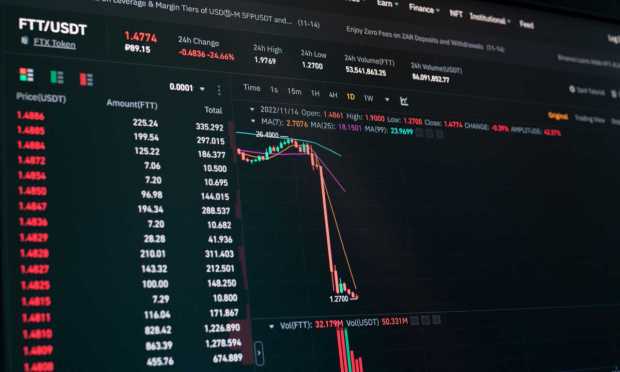FTX’s First Day in Court: ‘Personal Fiefdom of Sam Bankman-Fried’

Almost a full two weeks after first filing for bankruptcy on Nov. 11, the insolvent cryptocurrency exchange FTX finally held its first-day motion requests on Tuesday (Nov. 22). The hearing took place in Wilmington, Delaware, the traditional city where corporate bankruptcy cases are heard.
Presided over by Judge John T. Dorsey of the U.S. Bankruptcy Court for the District of Delaware, the Tuesday session focused on what assets FTX has, to whom they are owed, and where the overall bankruptcy case for FTX and its affiliates should be held.
The remaining “how” of the once-popular crypto exchange’s implosion has been widely covered; while the “why” will have to wait, or be speculatively guessed at, as Sam Bankman-Fried (SBF)’s now-infamous claims of being motivated by the Effective Altruism movement have been largely debunked by the industry-wide fallout from his group of companies’ failures.
James “Jim” Bromley, co-head of white shoe law firm Sullivan & Cromwell’s Global Finance and Restructuring practice, is acting counsel to FTX’s newly installed leadership team. He called the bankruptcy case “unprecedented” during his opening remarks. “We have probably witnessed one of the most abrupt and difficult corporate collapses in the history of corporate America,” he went on to say, as reported by Bloomberg.
What Assets FTX Has
Bromley walked the court through each key moment in the FTX collapse, from the leak of sister trading firm Alameda Research’s balance sheet to the announcement by Changpeng Zhao (CZ), the CEO of rival cryptocurrency exchange Binance, that he planned to liquidate his FTT holdings, the crypto token minted by FTX, and the subsequent new-age bank run on FTX that CZ’s reveal caused.
The Sullivan & Cromwell partner, widely considered a first-rate bankruptcy lawyer with decades of experience working on behalf of both governments and private enterprises, outlined the main business entities of SBF’s family of affiliated companies: FTX.com, FTX US, FTX’s venture arm, and trading firm Alameda Research, which holds the largest cash balance among the core four listed. The corporate governance in place for each of the main business verticals was minimal, consisting primarily of SBF and a close coterie of intermingled deputies.
The court has been told FTX has 36 banks and more than 200 bank accounts, and the enterprise group of companies employed a little over 500 people, the majority of whom were based in the U.S., followed by Japan, then Turkey. SBF and other key leaders lived in a shared penthouse in the Bahamas.
As reported by PYMNTS, with the help of turnaround firm Alvarez & Marsal, $1.24 billion in cash was uncovered at the FTX group of companies leading up to the first-day motions, a much higher tally than was able to be confirmed by FTX.
It is not all good news, however, as Bromley indicated to the court that a “substantial amount” of FTX Group’s assets “have either been stolen or are missing.”
It is unclear whether the “substantial amounts” that were stolen or mishandled include the several billion in combined loans that Alameda Research reportedly made to SBF, two of his deputies, and a company majority-owned by him; or are separate from them.
In October of last year, SBF also raised $420 million from investors on behalf of FTX — only he paid himself $300 million of that amount, claiming it as a personal reimbursement for re-purchasing the 15% stake in the exchange held by rival company Binance.
Actions like these are presumably what led FTX attorney Bromley to tell the judge today that the company was being “run as a personal fiefdom of Sam Bankman-Fried.”
Who FTX Owes Money To
FTX is bringing on investment banking advisory firm Perella Weinberg to help maximize the value of its remaining viable assets either through reorganization or strategic sales.
Who FTX owes money to is a double-edged sword, as revealing their names could imperil the rest of the industry and send unintended shockwaves that leave millions of users exposed to the fallout. Certain industry actors, as reported by PYMNTS, such as BlockFi and Genesis have already disclosed their FTX exposure.
FTX owes its top 50 creditors a staggering $3.1 billion, with the top 10 all due over $100 million each, as PYMNTS reported. The court was told that top locations for FTX’s customers include the Cayman Islands and the U.S. Virgin Islands.
The U.S. Trustee, a unit of the Justice Department responsible for overseeing bankruptcies, indicated that they oppose the redaction of the names of corporate and non-individual FTX customers, but Dorsey, the judge overseeing the case, has ruled that the creditor list will remain redacted on an interim basis as more information is provided to the court.
Along with FTX’s customer and creditor list, lawyers for the exchange have also asked Dorsey for an indemnification and exculpation motion keeping secret the details of those firms which the company has engaged to track down FTX’s remaining assets, as well as to protect the bankrupt platform from bad actors attempting to hack into these assets.
Such a motion is meant to prevent the advisors engaged by FTX, who are just doing their jobs, from being sued by creditors if the case does not turn out the way they hoped, giving them protection from entanglement in subsequent lawsuits.
Where The Chapter 15 Bankruptcy Case Will Be Held
A key takeaway from the first-day motions held earlier was that court officials in the Bahamas have officially agreed to let the U.S. court in Delaware handle part of the FTX restructuring case, acquiescing to a request to move a case filed in New York to join the remaining cases in Delaware.
Had the Bahamas officials dissented, it would have set up the potential for two different U.S. judges, each handling separate pieces of the FTX bankruptcy case, to deliver two court rulings that may have contradicted each other. Now, Dorsey will oversee the bulk of the FTX bankruptcy case.
